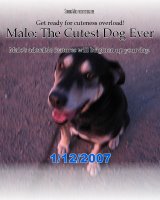Open Source Products I Use and Recommend
One application I consistently use and miss dearly in my work computing environment is the open source image editing product, the
GIMP. (I know, the name sounds odd, but it stands for the GNU Image Manipulation Program.) It is a feature-rich image editor that competes with the commercial and quite expensive Adobe Photoshop, with its current MSRP of $649. I can use the GIMP for simple image editing tasks, but it also works for more complex image editing jobs for print. The interface is intuitive and easy to use, it doesn't take up a load of processing power like Photoshop always seems to, and there is a wealth of resources available on the Web for extending it or customizing its features. It is available for Windows and Mac platforms, as well as for Linux and other Unix based platforms.
A remarkable feature about this product is that it is free, as in free beer. You get to download it and use it for free, never having to pay a company or to register your user information for updates. Why? GIMP is an
open source project, in which a dedicated distributed group of volunteer coders work on a project collaboratively, without direct financial benefit.
I also use an open source suite called
OpenOffice.org, which means I don't have to pay and, most importantly, I don't have to use the rather frustrating and bloated Microsoft Office; Microsoft Office for the Mac retails for $349 whereas OpenOffice.org gives me bloat for free! If you're a Mac user, check out
NeoOffice.org, an OpenOffice.org variant with a Mac look-and-feel.
OpenOffice.org includes replacements for Word, Excel, PowerPoint, as well as a drawing program, form template, and a formula editor. In my personal experience, OpenOffice.org handles multilingual documents more elegantly than Microsoft Office. OpenOffice.org also allows me to save my documents as PDF files, which is a very useful feature that is lacking in Microsoft Office. As with the GIMP, this product is also available for the Windows and Mac platforms, as well as for Linux and other Unix based platforms.
During library school, I wrote extensively about how the key concepts and values behind open source software. These include freedom to share, access, and social values, and are closely aligned to those of public libraries. Open source software also offers a myriad of financial and technological advantages. Existing open source projects for libraries enjoy vibrant development efforts, and successful implementations are promising, with significant ROI. To learn more, visit
http://www.oss4lib.org.
I think that although in most large library organizations, IT decisions are quite centrally dictated (and with good reason to do so!!), librarians should be aware that other computing choices exist outside of Microsoft-land. We can also consider offering open source applications on existing Windows machines, or lending multi-platform open source applications as part of our collection.
Labels: GIMP, open source, OpenOffice.org, OSS




